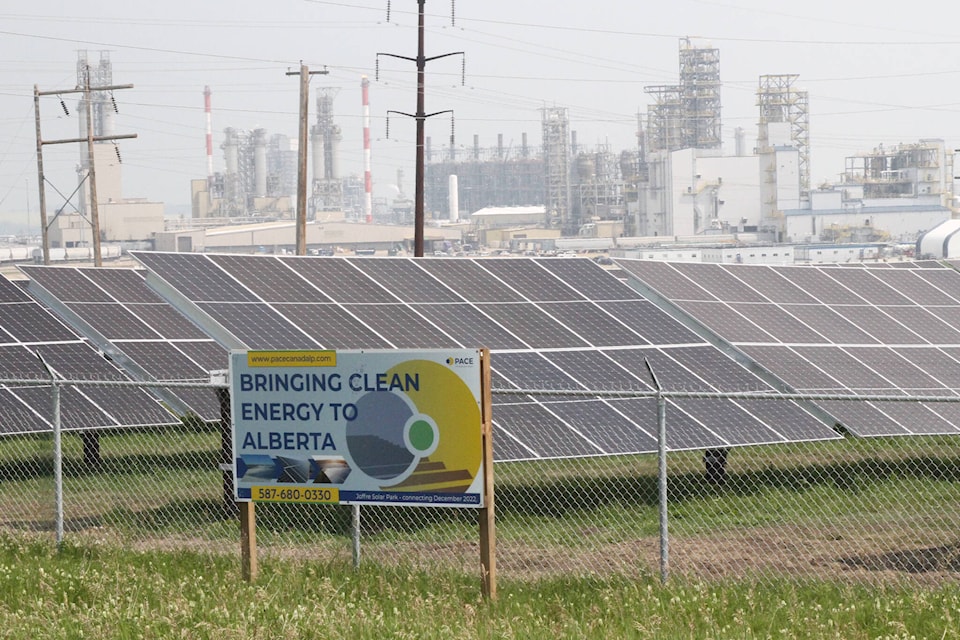In a few weeks, the switch will be thrown on a 47-megawatt solar power facility near Joffre and electricity will surge into the provincial grid.
And the company behind that $65-million project, PACE Canada LP, says it’s just getting started.
An application has already been filed to the Alberta Electric System Operator (AESO) for Joffre 3, a 300-megawatt solar power project. If approved by AESO, which oversees the province’s electricity system, the solar power project will be built in phases, beginning with a 100-megawatt facility that could be producing power by 2026.
The project is one of 14 in the works across Alberta by PACE Canada LP, said Claude Mindorff, the company’s director of development.
A 16-megawatt project in Caroline is in the approval process and other smaller 10- to 25-megawatt community-based projects are also planned for Sundre and Blackfalds in central Alberta. Others will be built in Killam, Viking, Lougheed, Provost, Brooks and Bassano among other communities.
The Joffre project soon to be energized will showcase the company’s goal of combining renewable energy with agriculture, known as agrivoltaics.
“Of the 192 acres we’ve leased, we’ve only lost seven and most of that was for the emergency road around the site,” said Mindorff.
Beneath the fixed solar arrays, the Morton family that has grazed cattle on the land for generations will be using the land for grazing sheep. At the same time, an estimated 47,000 tonnes worth of carbon dioxide emissions will be reduced each year and 1.4 million tonnes over the 25-year life of the project.
PACE has been on the leading edge of agrivoltaics in Canada and helped start Agrivoltaics Canada, a non-profit association based out of the University of Western Ontario, where a research group is focused on finding ways to increase the use of renewable energy in farming.
Mindorff said combining agriculture and solar power is not new.
“Canada is just behind the times. There’s about 14,000 megawatts of agrivoltaics projects around the world, growing everything from tomatoes and peppers to leafy greens, vines and tender fruits.”
The proposed 300-megawatt project promises to take solar power to another level. The facility will be designed to allow row cropping, or farming the land between the arrays.
“The new arrays we’re designing will have specifically designed racking systems,” said Mindorff. “The rows will be further apart so we can actually continue row cropping. So, our goal is to increase the amount of crop production amongst the solar arrays.
“We’re going to be tracking soil conditions, biomass, biodiversity. There will be honey harbours on the corners and we’re going to be planting some native grass species on the outside of the fence to promote pollinators.”
Unlike, the 47-megawatt project, which has fixed solar arrays, Joffre 3’s arrays will track with the sun to produce the optimum amounts of electricity. It also allows them to be shifted out of the way of farm equipment, such as seeders and sprayers.
“They can be tilted in one direction so you can do your rows like you normally would. Then you just turn the solar array the other way and come back and finish the field.”
The company has also been working with a firm that builds solar power racks to develop versions that can mount irrigation systems in solar arrays to improve crop growth. The power for the pumps will come from solar energy.
“The target is for us to find ways to take agriculture to net-zero and we’re going to use our solar programs to promote that.”
The rapid growth in solar power in Alberta has some rural landowners concerned about losing good farmland.
Mindorff looks at it a little differently.
“I like to put the shoe on the other foot. People say we’re destroying farmland or taking it out of production. I like to say we’re showing a different way to farm that can take farming to net-zero.
“Food production produces 27 per cent of Canada’s greenhouse gases. It’s a big chunk. It’s bigger than cement. It’s bigger than oilsands, and we’re all on those industries to get them to net-zero.”
There is some reluctance to pressure the agriculture industry, which feels it is being hit hard by carbon taxes, to continue to change the way they have been operating.
“PACE’s objective is to show how it can be done and be profitable and to allow solar energy to be the driver for it.”
Another PACE initiative will see former Westmoreland Coal Company mine sites re-purposed into solar facilities. The plan is to build the first 13-megawatt solar project — billed as the first development of its kind in Canada — at a former coal mine near Hanna. A 65-megawatt project is planned for a mine site near Forestburg.
“That’s very exciting because we’ll be able to prove that we improve soil quality over time,” he said, adding that before and after soil samples will be taken to provide data. “We think it’s got huge potential.”
PACE is not only focused on solar. The company is working with a community to develop batteries to store energy and promote electric vehicle charging.
The company is also getting involved in small-scale hydrogen production to create transportation fuels.
“Eventually tractors will convert to electric or hydrogen, so, we’ll be ready when they do.”
